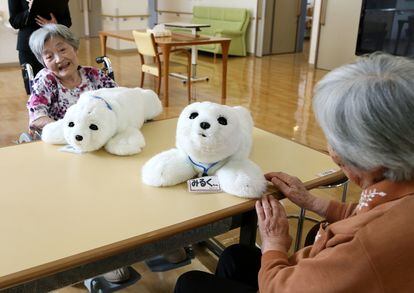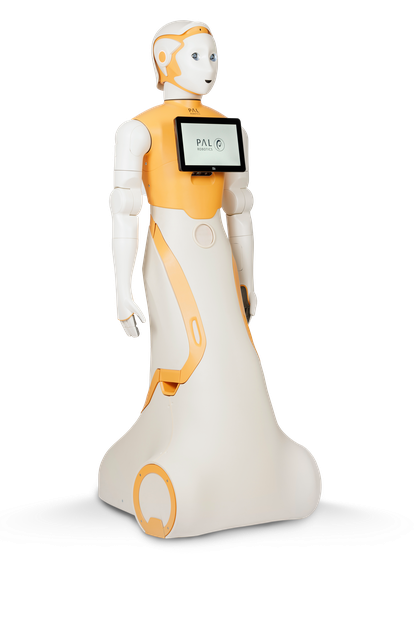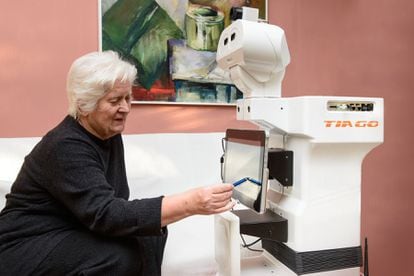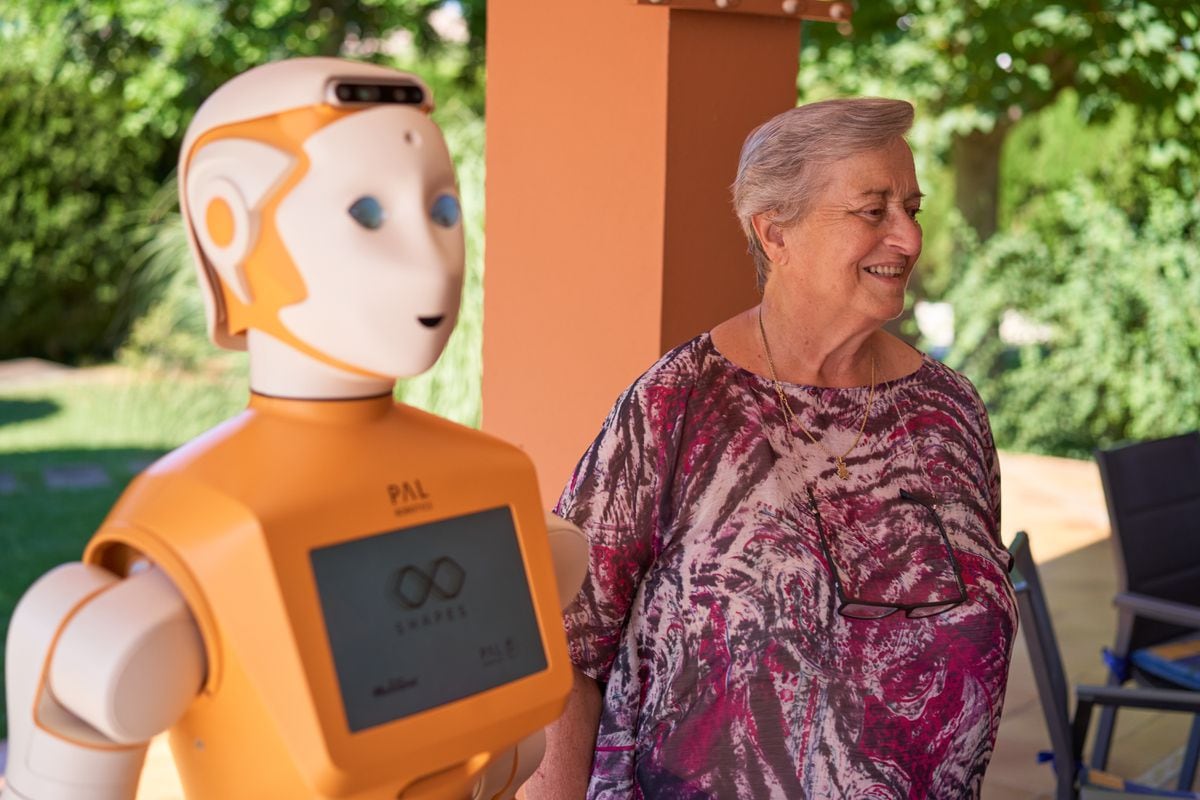9 years in the past, a plump white robotic — with a spherical head and tiny black eyes — reached the screens and hearts of thousands and thousands of individuals… each kids and adults alike.
This was Baymax, the protagonist of Disney’s Huge Hero 6, an endearing character impressed by certainly one of Marvel’s lesser-known comics. It didn’t take lengthy for the movie to turn into a traditional and for toy variations of the lovely machine (who resembles a pillow) to be offered in every single place.
However Baymax — along with being huggable and marshmallow-like — has one other operate: he’s a caretaker robotic. “I’m Baymax, your private healthcare companion,” he introduces himself within the movie. The rotund machine can detect when somebody is harm: he’s armed with a scanner to investigate very important indicators and may deal with any ailment, each bodily or emotional.

This isn’t the primary film robotic that the general public has fallen in love with. Wall-E, Astro Boy, R2-D2 and his companion C3PO achieved this nicely earlier than Baymax, whereas movies corresponding to Terminator or Blade Runner laid the foundations for the style. Nevertheless, Baymax is likely one of the few robots to have appeared on the large display who was created with the target of caring for human beings.
Tales about robots that take care of the sick or the aged have been making headlines for years. In Japan, the promotion of care robotics in hospitals or nursing houses has been the order of the day for many years. Assistive robotics is offered as an answer to the care disaster in a society that’s quickly getting old, the place the length and necessities of long-term care solely proceed to develop, with out the mandatory public funding to alleviate pressures.
Such an answer isn’t with out backlash. This previous week, the regional authorities of Catalonia in Spain introduced that it’ll allocate the equal of $6 million to buy 1,000 service robots to take care of the aged. Nevertheless, the union {of professional} caregivers denounced that this measure is merely designed to exchange them, to not enhance their working circumstances.
As synthetic intelligence (AI) more and more infiltrates on a regular basis duties, it has been extra ceaselessly thought of as a possible helper within the long-term care sector. With an unstoppable advance, a future crammed with tremendous caring machines not looks like one thing out of a film. However can robots actually take care of the aged or sick? How would they achieve this? And what moral implications does this have? The place’s the restrict?
This previous July, the journal Science Robotics revealed a report — carried out by researchers on the universities of Auckland, Duke and Cornell — on how companion robots (geared up with AI) can turn into instruments to assist enhance the social connections of single folks. Elisabeth Broadbent — a professor of Psychological Drugs on the College of Auckland and one of many researchers who participated within the research — explains to EL PAÍS through e mail that “it has already been proven in scientific research that robots cut back loneliness” and that machines particularly designed to accompany folks exist already. One among these is manufactured by the corporate PARO. It’s a small therapeutic robotic that resembles a child seal. Wanting like a stuffed animal, it was provided to individuals who survived the earthquake and tsunami that devastated the coast of Japan in 2011.
“Robots can join folks by video calls and remind them of their social commitments. With new AI giant language fashions, robotic conversations may be extra private and tailor-made to the person,” Broadbent notes. This personalization, she continues, is what makes those that use them really feel heard and cared for. Machines “may also find out about folks by repeated conversations and keep in mind to observe up on necessary subjects.” However for this to be potential, she clarifies, human management is important to control the use and assure equitable entry to this know-how. Private knowledge have to be stored non-public and the knowledge supplied by the machine must be fully dependable. There have to be a human test in case the robots make a mistake.
Irene Lebrusán — a sociologist and researcher on the Worldwide Heart on Ageing (CENIE) — thinks that it’s key to distinguish between undesirable loneliness and tedium. “For those who take a woman who’s alone all day and provides her a doll, the girl will likely be entertained for some time. Does that imply we’ve addressed her downside of undesirable loneliness? Completely not. Undesirable loneliness means having inadequate or low-quality social relationships. A machine won’t ever, ever be capable to resolve this challenge,” she warns.

Concerning the duty that Broadbent spoke of, Alan Winfield — an engineer and professor of Robotic Ethics at UWE Bristol College — expresses his related issues to EL PAÍS: “One of many issues that worries me — particularly with older folks, kids or folks with mental disabilities — is that they could come to imagine {that a} robotic cares about them.” He believes it’s mandatory to exactly outline the kind and performance of robots which are used for care: to distinguish these meant to supply firm and emotional help — such because the automated seal — from those who present bodily and medical help. Within the latter class, the dangers are better. “In the long run, these care robots tackle features which will appear easy, however they’re truly crucial, corresponding to reminding an individual to take their medicine, or protecting observe of the variety of instances a affected person has had a drink of water.”
Within the occasion that one thing goes mistaken, the important thing factor for Winfield is to specify what precisely went mistaken, why it occurred and how you can keep away from it. To this finish, he and his crew advocate for the creation of “moral black containers.”
“That is the robotic equal of an plane flight knowledge recorder. An airplane wouldn’t be allowed to fly with out it. All robots — particularly social ones, which embrace assistive robots, robots in hospitals, in nursing houses or in non-public houses — have to be geared up with one,” he affirms.
Even so, the professor believes that, for now, caregiver robots can carry out easy duties, corresponding to bringing a glass of water from the kitchen to somebody, or transmitting an aged particular person’s name for assist. However he emphasizes that we’re far-off from these machines being deployed to long-term care houses or being allowed to bodily help folks as they gown or undress, or get in or off the bed. “[Robots] nonetheless can’t try this safely and reliably. We want testing, security ensures and rules. We additionally want to know that assistive robots ought to by no means be used as substitutes for human caregivers. They need to assist them, not exchange them,” he warns.

In Spain, one of many main corporations in assistive robotics is PAL Robotics. Based in 2004, its machines are marketed all through the world. The corporate has participated in a number of pilot tasks within the European Union with two of its humanoid robots, named ARI and TIAGo. These robots are designed to assist aged folks of their every day duties.
Narcis Miguel Baños — the pinnacle of the Social Robotics unit on the agency — sees a future “the place help robots play a key position.” However to construct that future, he says that it’s important “to conduct many extra pilot checks in ‘actual’ environments” and for engineers and care professionals — together with docs, nurses and homecare staff — to collaborate. “Perhaps we designed a cell robotic that may do issues with its arm and transfer objects up and down, however what we envision as engineers might not be what the market and folks want,” he acknowledges, in a video interview with EL PAÍS.
In the present day, Baños factors out, “all a majority of these robotic purposes are nonetheless within the analysis part” and the subsequent step is to “specify what kind of duties we would like every robotic to do. We have to be very particular.” One of many predominant difficulties that the skilled warns about is balancing particular person wants with collective wants. Making these machines socially-acceptable can be a problem. “Medical assist is simpler to know than the concept that this robotic may also supply emotional help to an individual.”

Silvia González — head of AI on the Technological Institute of Castilla y León (ITCL) — agrees that emotional help from robots “is taking its first steps.” In January, checks started with Pepper — a humanoid robotic designed in Japan — in a care middle for the aged. “The bottom line is to adapt it in order that customers don’t really feel diminished, however moderately see that they’re able to doing issues [with the help of the machine]. However there’s nonetheless a protracted solution to go earlier than a traditional dialog can happen, the place gestures are recognized and the robotic can know if you’re comfortable or unhappy.”
How might this be executed? Nicely, González explains that, if an individual takes longer than traditional to reply, or stops doing their really useful workouts — which they could have been doing and not using a downside — “the system can decide that there’s an absence of attachment to the robotic and that one thing is mistaken. One thing could have occurred to the affected person.”
Demystifying Japan
Again in 2007, James Wright — a professor at Queen Mary College of London — turned fascinated by robots, particularly the advances being made in Japan, whereas finishing his thesis. “At first, I actually thought that robots would turn into extremely popular and customary. After which, I went to Japan,” he explains through video name.
He spent a number of months within the nation, touring care facilities and speaking to staff and sufferers. From these visits, the ebook Robots Received’t Save Japan (2023) was born. “There was a disconnect between the folks growing the robots and the tip customers. New sorts of duties emerged, like having to maneuver them [from one place to another], continuously [informing] the residents about them, updating them, cleansing them…”
The professor warned then — and reaffirms now — that extending using caregiver robots goes to be far more sophisticated than what has been promoted. “I talked to a number of nursing dwelling directors who purchased a robotic. It usually ended up sitting in a closet, as a result of they didn’t have workers to oversee using it all through the day. Japan predicted that the longer term market could be [dominated] by a majority of these robots, with half-a-trillion {dollars} a 12 months being spent on them by 2025. It hasn’t occurred. The fact is that these units are actually costly and don’t save on labor.”
For Wright, earlier than deciding which machines will do what (and the way and when), society should first reply the next query: “What does it imply to care?”
Join our weekly e-newsletter to get extra English-language information protection from EL PAÍS USA Version

